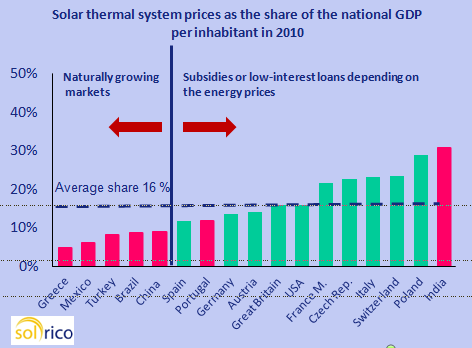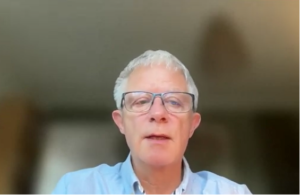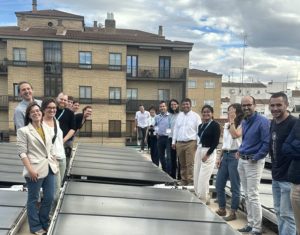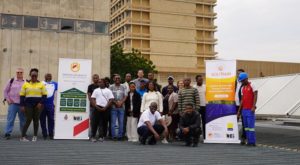New ISOL Navigator Study Compares Solar Thermal System Prices and Market Attributes
January 10, 2012
 One of the major barriers to growing any solar thermal market is the high upfront investment needed for setting up a solar thermal system. The figure above shows how much or how little a solar thermal system costs in different countries. It displays the net system prices of solar water heaters in relation to the national Gross Domestic Product (GDP) per inhabitant, excluding investment subsidies or tax reductions. The lower the percentage, the easier it is for people to afford a solar thermal system. In Greece and Mexico, systems are relatively cheap, whereas in Poland and India, customers have to dig deep into their pockets. The red bars stand for thermosiphon systems, the green bars for pumped systems. The comparison is part of the latest ISOL Navigator study, which was carried out by German agency solrico in December 2011. Source: Solrico
One of the major barriers to growing any solar thermal market is the high upfront investment needed for setting up a solar thermal system. The figure above shows how much or how little a solar thermal system costs in different countries. It displays the net system prices of solar water heaters in relation to the national Gross Domestic Product (GDP) per inhabitant, excluding investment subsidies or tax reductions. The lower the percentage, the easier it is for people to afford a solar thermal system. In Greece and Mexico, systems are relatively cheap, whereas in Poland and India, customers have to dig deep into their pockets. The red bars stand for thermosiphon systems, the green bars for pumped systems. The comparison is part of the latest ISOL Navigator study, which was carried out by German agency solrico in December 2011. Source: Solrico
One of the major barriers to growing any solar thermal market is the high upfront investment needed for setting up a solar thermal system. The figure above shows how much or how little a solar thermal system costs in different countries. It displays the net system prices of solar water heaters in relation to the national Gross Domestic Product (GDP) per inhabitant, excluding investment subsidies or tax reductions. The lower the percentage, the easier it is for people to afford a solar thermal system. In Greece and Mexico, systems are relatively cheap, whereas in Poland and India, customers have to dig deep into their pockets. The red bars stand for thermosiphon systems, the green bars for pumped systems. The comparison is part of the latest ISOL Navigator study, which was carried out by German agency solrico in December 2011.
To make prices comparable across national boundaries, they are calculated in the purchasing power of each country, using the annually updated purchasing power parity (ppp) exchange rates by the International Monetary Fund (IMF). Goods prices are converted from national currency to reflect the comparable purchasing power for a goods basket in the USA. The chart above shows the net system prices in a particular country converted into purchasing power parity (ppp) Dollars and compared to the GDP per inhabitant in ppp Dollars. A share below 10 % characterises countries with a naturally growing solar thermal market. Markets above 10 % usually require investment subsidies and/or low interest loans depending on national energy prices.
India has the lowest GDP per head of all solar thermal markets included in the ISOL Navigator study, and Poland has the lowest GDP per head of all European countries within the survey. This means that in both countries, the price tag of a solar water heater is high in relation to the GDP per head: India has a share of 31 % and Poland one of 29 %. Looking at these figures, it will not come as a surprise that the Indian solar thermal market – although being a BRIC country in the sunbelt of the globe – is strongly dependent on investment subsidies. What made the slowly growing market finally explode was the start of the nation-wide grant programme by the Indian Ministry of New and Renewable Energy (MNRE). In Poland, on the other hand, it was the up-to-40% investment subsidy offered by the NFOŚiGW fund which pushed the market in 2011.
Germany and Austria are at the centre of the chart. However, this is only so because the figure compares solar hot water system. As the far more expensive combi-systems are becoming the dominant technology in these countries, their position would actually have to be shifted to the further right of the chart.
Because the purchasing power of the population is high in the USA, solar thermal systems are affordable for US-Americans (16 % of GDP per head). Still, the market is not picking up as hoped, because energy prices have been too low, and gas and electric water heaters are quite cheap compared to solar water heaters.
ISOL Navigator December 2011 is an international study based on 383 filled-in questionnaires from relevant solar manufacturers and system suppliers worldwide. The study shows the current and future market development of the global solar thermal sector and analyses the market situation in 16 key solar heating countries. The ISOL Navigator is based on the ISOL Index, an international business climate index, which was developed by solrico at the beginning of 2010. For the first time, the ISOL Navigator highlights winners and losers across the solar thermal supply chain, and looks at solar thermal system prices and their influence on the development of national markets.
More information:
http://www.solrico.com/en/navigator.html


